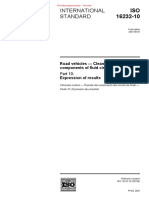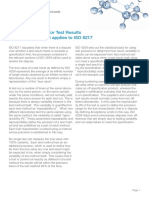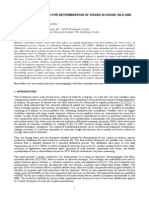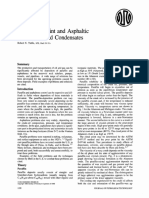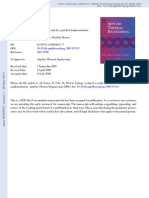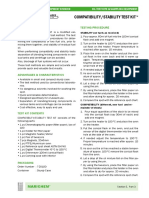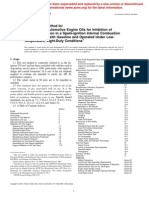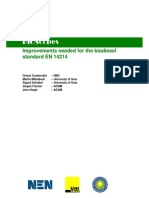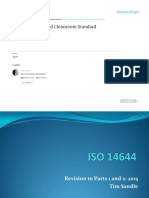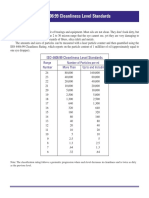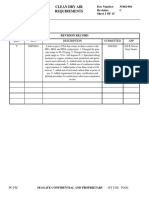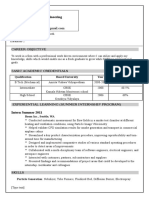IP 565 Water Effect On Particle Counting
IP 565 Water Effect On Particle Counting
Uploaded by
Jorge MuñizCopyright:
Available Formats
IP 565 Water Effect On Particle Counting
IP 565 Water Effect On Particle Counting
Uploaded by
Jorge MuñizOriginal Description:
Original Title
Copyright
Available Formats
Share this document
Did you find this document useful?
Is this content inappropriate?
Copyright:
Available Formats
IP 565 Water Effect On Particle Counting
IP 565 Water Effect On Particle Counting
Uploaded by
Jorge MuñizCopyright:
Available Formats
New revisions to IP 565 for Particle Counting in
Jet Fuels improve accuracy
PARTICULATE IN JET FUELS – WHY IS MEASUREMENT SO IMPORTANT?
The issue of particulate contamination in Jet Fuel has long been recognised for its associated problems
affecting the fuel economy of aircrafts and causing maintenance down time issues. The appearance of
particulate material can affect fuel lines and filters which subsequently block the flow of fuel to the engine, it
can also cause fuel injection system problems reducing combustion efficiencies.
Particulate measurement is an established means of monitoring quality control and product release and is
classified by particle size. Laser obscuration has become an established method of measuring the
particulate contamination in fuels worldwide. The Energy Institute test method IP 565 for aviation turbine fuel
is referenced in the DEF STAN 91-91 Fuel Specification. The ASTM test method D7619 for middle distillate
fuels (which includes aviation turbine fuels) is also included in the D975 diesel specification for quality control
purposes.
LASER PARTICLE COUNT – THE PREFERRED TEST FOR SAMPLE DIAGNOSIS
Laser obscuration based particle counting methods
have a number of advantages over the traditional
gravimetric method; these include short test times,
simple operation and immediate results which
indicate particle size and distribution. Laser particle
counting uses the light emitted by a laser to
illuminate a cell through which the sample is
passed. Particles present in the sample cast a
shadow onto the sensor within the cell, and as the
particle passes across the cell the voltage output
of the sensor drops. The voltage drop of the cell is
proportional to the particle size and the size of the
particle is calculated based on this principle.
The availability of reliable automatic particle counting
apparatus and test methods, including AvCount and
IP 565, has made these test methods a viable option
for specification purposes. The improved precision of
these methods has resulted in some standardisation
authorities stating their intention to replace
gravimetric tests with laser obscuration particle
counting tests at the earliest opportunity.
DETERMINING THE LIMITS
Determining the limits that should be applied to laser obscuration particle counting test methods has
historically proved difficult. The wide variation of the density of particulates precludes an accurate correlation
between the established gravimetric limits and laser obscuration particle counts. A further complication is
that laser obscuration methods do not easily differentiate between particulates and dispersed water (free
water droplets).
E: info@seta-analytics.com T: +44 (0)1932 575000 F: +44 (0)1932 568363 W: www.seta-analytics.com
One proposal is that the limits should be similar to those of the World Wide Fuel Charter:- 18/16/13 (ISO
4406 Cleanliness Codes) at ≥4, ≥6 and ≥14µm(c) respectively, while others proposals have suggested more
stringent levels. However, research has shown that jet fuels that pass the gravimetric test could easily
exceed the proposed limits due to the presence of dispersed water, even though the volume of dispersed
water is within permitted limits.
In the past, it was considered that the dispersed water droplet size would tend to be ≥25µm(c) and therefore
would not interfere with the results for the ≥4, ≥6 and ≥14µm(c) size bands that are key in particle counting
analysis. However, the improved precision of modern laser obscuration particle counters has now shown
that the dispersed water can have a significant distribution in these smaller size bands, especially
downstream of high shear pumps.
THE EFFECT OF DISPERSED WATER ON PARTICLE COUNTS IN JET AND HOW TO NEGATE IT
Chart 1 below illustrates the effect of dispersed water on the particle count of a jet turbine fuel. The fuel had
been dosed with 0.5mg/l of ISO Medium Test Dust to give a moderate particle count and all three samples
are within ‘normal’ gravimetric particulate and dispersed water limits. However, whilst the sample with no
added dispersed water gives a cleanliness code of 17/15/10 (ISO 4406), the +20ppm dispersed water
sample gives a cleanliness coding of 20/20/18 (ISO 4406), and the +40ppm dispersed water sample gives a
cleanliness coding of 21/21/19 (ISO 4406) using laser obscuration methods.
21
ISO 4406
Codes
20
19
Particles/ml
Size µm(c)
Jet A1 + 0.5mg/l Dust
Chart 1: The Effect of Dispersed Water on Particle Counts in Jet A1
This summarises the problem; setting limits that are too low would risk failing clean but (acceptably) ‘wet’
fuels, whilst setting high limits to take into account the permitted levels of dispersed water would risk passing
a very dirty but ‘dry’ fuel.
E: info@seta-analytics.com T: +44 (0)1932 575000 F: +44 (0)1932 568363 W: www.seta-analytics.com
NEGATING THE EFFECT OF WATER ON PARTICLE COUNTING
One method of removing the effects of dispersed water is to dissolve it into the fuel. However, the fuel only
has a limited propensity to dissolve water and reaches saturation point quite quickly. This can be
circumvented by the use of a cosolvent that has an affinity to fuel and water.
Recent revisions to IP 565 have provided an optional procedure (Annex B) to eliminate the effects of water in
particle counting. Annex B describes the procedure for the addition of either a cosolvent or a proprietary
chemical to the sample to increase the accuracy of the particle count by eliminating free water interference.
The procedure is optional but shows good results so it is expected that many users will adopt it as a
standard procedure. Others may choose to only use it to clarify whether a high count was due to dirt or water
droplets.
For an example of the results see Chart 2 which illustrates the effect of adding 5.5% V/V cosolvent to the
water contaminated samples shown in Chart 1.
THE EFFECT OF ADDING COSOLVENT TO THE WATER CONTAMINATED SAMPLES
21
ISO 4406
Codes
20
19 Particles/ml
Size µm(c)
Jet A1 + 0.5mg/l Dust
Chart 2: The Effect of Cosolvent on Particle Counts in Water Contaminated Jet A1
The cosolvent treatment has successfully removed the effects of the dispersed water on the particle count.
In fact, the raw data shows that the count is slightly lower than the original fuel due to the removal of the
small amount of dispersed water that was present in the original sample.
Further tests show that the addition of 5.5% v/v cosolvent continues to be effective, even when the dispersed
water content exceeds the maximum levels normally permitted in jet turbine fuel, as shown in Chart 3.
E: info@seta-analytics.com T: +44 (0)1932 575000 F: +44 (0)1932 568363 W: www.seta-analytics.com
22
ISO 4406
Codes
21 Particles/ml
20
19
Size µm(c)
Jet A1 + 0.5mg/l Dust
Chart 3: The Effect of 5.5% v/v Cosolvent on Particle Counts up to 100ppm Dispersed Water
THE FUTURE OF LASER PARTICLE COUNTING
The migration from gravimetric testing to laser based particle counting has been underpinned by work from
the Energy Institute (EI). In March the EI made two revisions to the Laser obscuration based particle
counting methods to improve the reliability of these test methods.
Revision 1 - Determining verification tolerance
The fuel industry methods of particle counting were derived from methods used for hydraulic oils originally
devised in the 1960s. At that time, the technology limitations were such that accuracy, repeatability and
reproducibility were relatively poor.
Furthermore a system of coding was introduced that converted particles/ml into cleanliness codes to make it
easier for an operator to report results. The problem was that these codes are quasi-logarithmic which allows
for a large range of particle counts to be covered by a single cleanliness code, the result is potentially
misleading tolerances.
Energy Institute investigations carried out during 2011 and 2012 revealed that more precise technology is
now available. Highly coherent solid state lasers, low noise electronics and advanced digital processing have
considerably improved the precision of laser obscuration instruments like AvCount. As a result, the EI has
revised the tolerances for calibration and verification.
The revised tolerance is statistically derived from the particle counts for the batch of verification material and
the reproducibility (R) of the test, whereas the previous particle count tolerance for verification was based on
the ISO cleanliness code. Using the reference standards recommended in ISO 11171 (the “core” ISO
governing the design and calibration of Automatic Particle Counters), a particle counter would be verified
using a material with a count of approximately 6000 @ ≥4µm(c). Using the “within 1 ISO cleanliness code”
tolerance, a count between 5001 and 10 000 particles/ml would be acceptable. Under the revised tolerances
the limit would be approximately 5400 to 6400 particles/ml @ ≥4µm(c).
E: info@seta-analytics.com T: +44 (0)1932 575000 F: +44 (0)1932 568363 W: www.seta-analytics.com
Revision 2 - IP 565 Annex B: Procedure to eliminate the effects of water in particle counting
IP 565 Annex B describes the procedure for the addition of either a cosolvent or a proprietary chemical to the
sample to increase the accuracy of the particle count by eliminating free water interference.
As discussed in the body of this article, water droplets in suspension could result in an unacceptably high
particle count, even though both the particulate and water content are within specification.
As a result of trials by the Energy Institute and particle counter manufacturers, it has been possible to
quantify the volume of cosolvent or chemical additive necessary to negate the effect of water on particle
counting in typical jet turbine fuels.
The procedure is optional so some users may adopt it as a standard procedure, whilst others may choose to
only use it to clarify whether a high count was due to dirt or water droplets.
EXTENSION OF TESTING INTO OTHER FUEL TYPES
The ASTM D7619 test method also covers diesels, bio-diesels and bio-diesel blends. These fuels suffer from
similar issues to jet turbine fuels. Diesels can contain greater levels of particulates, but they can also contain
a considerably greater volume of free water. This exacerbates the effect on the particle counting. Further,
free water droplets can cause severe damage to the latest generation extreme pressure injection systems.
The whole issue is further confused by the inclusion of bio-diesel. The fatty acid methyl esthers (FAME)
content has an effect on the solubility of water in the diesel.
A test program is currently underway to extend the co-solvent work into these fuels with conclusions
available late 2013.
For more information on AvCount visit www.seta-analytics.com
~ ENDS ~
E: info@seta-analytics.com T: +44 (0)1932 575000 F: +44 (0)1932 568363 W: www.seta-analytics.com
You might also like
- Astm D1655 22Document11 pagesAstm D1655 22JoaoNo ratings yet
- Astm D975Document28 pagesAstm D975Eder Fajardo Valencia100% (1)
- UOP 981-14 Trace Nitrogen in Liquid Hydrocarbons by Oxidative Combustion With ChemiluminescenceDocument9 pagesUOP 981-14 Trace Nitrogen in Liquid Hydrocarbons by Oxidative Combustion With ChemiluminescenceRamakrishnan HariNo ratings yet
- ASTMD396Document13 pagesASTMD396olga johanna rojas diaz100% (1)
- Afs 2005 - 2Document66 pagesAfs 2005 - 2Zeljko RisticNo ratings yet
- D5002 Density and Relative Density of Crude Oils by Digital Density AnalyzerDocument5 pagesD5002 Density and Relative Density of Crude Oils by Digital Density AnalyzerSergey GrigoryevNo ratings yet
- Iso 16232 10 2007 en PDFDocument8 pagesIso 16232 10 2007 en PDFyağmurNo ratings yet
- Rexroth Oil Cleanliness BookletDocument44 pagesRexroth Oil Cleanliness BookletM S Gokul100% (7)
- Determination of Total Oxygen in Gasoline and Methanol Fuels by Reductive PyrolysisDocument5 pagesDetermination of Total Oxygen in Gasoline and Methanol Fuels by Reductive Pyrolysisjawed iqbalNo ratings yet
- Oxidation Stability of Distillate Fuel Oil (Accelerated Method)Document6 pagesOxidation Stability of Distillate Fuel Oil (Accelerated Method)Pablo Fabian Del RossoNo ratings yet
- ASTM D95 13e1Document3 pagesASTM D95 13e1Edwin100% (1)
- Reid Vapour PressureDocument2 pagesReid Vapour PressureHicoolguy RiqNo ratings yet
- DVLS VUV Analyzer User Manual: Based On ASTM D8071Document22 pagesDVLS VUV Analyzer User Manual: Based On ASTM D8071Duy DangNo ratings yet
- Astm D4737 21Document3 pagesAstm D4737 21ammarNo ratings yet
- List-of-IP-Test-Methods 2017Document12 pagesList-of-IP-Test-Methods 2017Mark Baggott100% (1)
- Determination of Hydrogen Sulfide in Fuel Oils by Rapid Liquid Phase ExtractionDocument10 pagesDetermination of Hydrogen Sulfide in Fuel Oils by Rapid Liquid Phase ExtractionsasanNo ratings yet
- Thermal Oxidation Stability of Aviation Turbine Fuels: Standard Test Method ForDocument25 pagesThermal Oxidation Stability of Aviation Turbine Fuels: Standard Test Method Fordmvaldes21No ratings yet
- Octane Number PDFDocument9 pagesOctane Number PDFLê Ngọc Huyền80% (5)
- ASTM - D664 - 2009 Reapproved 2011 - Standard Test Method For Acid Number of Petroleum Products by Potentiometric TitrationDocument10 pagesASTM - D664 - 2009 Reapproved 2011 - Standard Test Method For Acid Number of Petroleum Products by Potentiometric TitrationsasanNo ratings yet
- Lube Tech093 ViscosityBlendingEquations - 2 PDFDocument4 pagesLube Tech093 ViscosityBlendingEquations - 2 PDFvivek20072008No ratings yet
- Acceptance Limits For Test Results Iso 4259 How Itapplies Iso 8217 NV1222Document2 pagesAcceptance Limits For Test Results Iso 4259 How Itapplies Iso 8217 NV1222abduNo ratings yet
- D 7152 - 11 (2016)Document9 pagesD 7152 - 11 (2016)Ippolito Gualdi100% (1)
- Alcohol OctaneDocument18 pagesAlcohol OctanetoanvmpetrologxNo ratings yet
- Wax DeterminationDocument12 pagesWax Determinationdrojas70No ratings yet
- EvidenciaDocument3 pagesEvidenciaKevin LealNo ratings yet
- Standard Method For BiomassDocument186 pagesStandard Method For Biomassqiwe0001No ratings yet
- AICHE2004Document19 pagesAICHE2004Antonio GuarascioNo ratings yet
- Iso 4264Document14 pagesIso 4264Gery Arturo Perez AltamarNo ratings yet
- High-Pour-Point and Asphaltic Crude Oils and CondensatesDocument5 pagesHigh-Pour-Point and Asphaltic Crude Oils and CondensatesarispriyatmonoNo ratings yet
- Conradson Carbon Residue of Petroleum Products: Standard Test Method ForDocument7 pagesConradson Carbon Residue of Petroleum Products: Standard Test Method ForNelson Jara CobosNo ratings yet
- RMA20951 P368367.3 FAME in AvturDocument52 pagesRMA20951 P368367.3 FAME in AvturKwabena AbrantieNo ratings yet
- Chemical Species in Marine Fuel Oil: ASTM D7845-13Document4 pagesChemical Species in Marine Fuel Oil: ASTM D7845-13Ian Ridzuan100% (1)
- Preflash DrumDocument27 pagesPreflash DrumGarry David100% (1)
- Treatment of Effluent From RefineriesDocument26 pagesTreatment of Effluent From RefinerieskalaiNo ratings yet
- Conversion Processes For SAFDocument2 pagesConversion Processes For SAFluchoosorioNo ratings yet
- Compatibility Stability Test KitDocument2 pagesCompatibility Stability Test KitAnonymous DklM65UWfmNo ratings yet
- Astm TestingDocument7 pagesAstm TestingFallo SusiloNo ratings yet
- Measurement of Hindered Phenolic Antioxidant Content in HL Turbine Oils by Linear Sweep VoltammetryDocument6 pagesMeasurement of Hindered Phenolic Antioxidant Content in HL Turbine Oils by Linear Sweep VoltammetryMohanadNo ratings yet
- Astm D-3242Document5 pagesAstm D-3242Gabriella Evelyn LopesNo ratings yet
- Manual Piston Cylinder Sampling For Volatile Crude Oils, Condensates, and Liquid Petroleum ProductsDocument14 pagesManual Piston Cylinder Sampling For Volatile Crude Oils, Condensates, and Liquid Petroleum ProductsjiandapaNo ratings yet
- Effect of Metal Contents On Oxidation Stability of Biodieseldiesel BlendsDocument5 pagesEffect of Metal Contents On Oxidation Stability of Biodieseldiesel BlendsKumar Vishal100% (1)
- Boiling Point Distribution of Samples With Residues Such As Crude Oils and Atmospheric and Vacuum Residues by High Temperature Gas ChromatographyDocument20 pagesBoiling Point Distribution of Samples With Residues Such As Crude Oils and Atmospheric and Vacuum Residues by High Temperature Gas ChromatographyTsogtsaihan MyahlaiNo ratings yet
- PonaDocument6 pagesPonaMahjabin Nadia100% (1)
- Crude Assay vs. HTSDDocument0 pagesCrude Assay vs. HTSDmahmoudmakladNo ratings yet
- Astm D1160 - 18Document20 pagesAstm D1160 - 18Metrologia Piedecuesta Solumed Ingenieria Ltda100% (2)
- ASTM D 6593 - 00 Rdy1otmtmdaDocument85 pagesASTM D 6593 - 00 Rdy1otmtmdaEnrique Alejandro OvandoNo ratings yet
- Improvements Biodiesel en 14214Document171 pagesImprovements Biodiesel en 14214Ramadhan Dipta MaulaNo ratings yet
- Astm D 2007 - 11 (Re:2016)Document8 pagesAstm D 2007 - 11 (Re:2016)alexander guerraNo ratings yet
- Chapter6a Hydrotreating 170106114901 PDFDocument26 pagesChapter6a Hydrotreating 170106114901 PDFMI MNo ratings yet
- Astm D 4810 - 2006Document3 pagesAstm D 4810 - 2006Nag RajNo ratings yet
- Determination of Vapor Pressure of Crude Oil: VPCR (Expansion Method)Document7 pagesDetermination of Vapor Pressure of Crude Oil: VPCR (Expansion Method)Cristhian Emmanuel GarridoNo ratings yet
- D5016Sulfur in AshDocument3 pagesD5016Sulfur in AshAdam PerkasaNo ratings yet
- FT-IR Analysis of Used Lubricating OilsDocument4 pagesFT-IR Analysis of Used Lubricating OilsMeetika Gupta100% (1)
- Crude Petroleum analysis handbook: Crude oil Quality control, #1From EverandCrude Petroleum analysis handbook: Crude oil Quality control, #1Rating: 4 out of 5 stars4/5 (1)
- NAS Doc. E7605-2-05-08 - Partikelmesstechnik PDFDocument22 pagesNAS Doc. E7605-2-05-08 - Partikelmesstechnik PDFer_sanjaypatel100% (1)
- Manual of Analysis and Comparison PhotographsDocument36 pagesManual of Analysis and Comparison PhotographsAnonymous OP4lm2PBDHNo ratings yet
- ATL ADocument3 pagesATL AMelis AvşarNo ratings yet
- Implementation of Preventive Diagnostics MeasuresDocument5 pagesImplementation of Preventive Diagnostics MeasuresPhilippe GayetNo ratings yet
- A New Method For Estimation of Automobile Fuel AdulterationDocument14 pagesA New Method For Estimation of Automobile Fuel AdulterationperryNo ratings yet
- Manual of Analysis and Comparison Photographs: System ConditionsDocument44 pagesManual of Analysis and Comparison Photographs: System ConditionsRichard De Medeiros CastroNo ratings yet
- Fluid Analysis for Mobile Equipment: Condition Monitoring and MaintenanceFrom EverandFluid Analysis for Mobile Equipment: Condition Monitoring and MaintenanceNo ratings yet
- CF-3264 Manual PG 00-29 (0507-000)Document30 pagesCF-3264 Manual PG 00-29 (0507-000)Jorge MuñizNo ratings yet
- CF-OPT-02: Olympic Bar HolderDocument2 pagesCF-OPT-02: Olympic Bar HolderJorge MuñizNo ratings yet
- Seated Mid-Row: Record Serial Number Here Catalog Number Customer ServiceDocument31 pagesSeated Mid-Row: Record Serial Number Here Catalog Number Customer ServiceJorge MuñizNo ratings yet
- Military Fuel HydrantDocument2 pagesMilitary Fuel HydrantJorge MuñizNo ratings yet
- 19722-0 SSAFLAB FiltrationDocument1 page19722-0 SSAFLAB FiltrationJorge MuñizNo ratings yet
- Gorman Rupp Pumps Engineering DataDocument25 pagesGorman Rupp Pumps Engineering DataJorge MuñizNo ratings yet
- ISO 14644 2015 - Pharmig XDocument36 pagesISO 14644 2015 - Pharmig Xmarwa100% (9)
- CETA Compounding Isolator Testing Guide CAG-002-2006: March 3, 2006 1.0 OverviewDocument21 pagesCETA Compounding Isolator Testing Guide CAG-002-2006: March 3, 2006 1.0 OverviewVictor GomezNo ratings yet
- Astm D7417 17Document6 pagesAstm D7417 17Najih MunawarNo ratings yet
- Integrity Testing of HEPA FiltersDocument3 pagesIntegrity Testing of HEPA FilterspradeepNo ratings yet
- Icount LCM20Document5 pagesIcount LCM20Subash SenwarNo ratings yet
- RP Ind Technical Appendix ISO 440699 Cleanliness Level Standards PDFDocument2 pagesRP Ind Technical Appendix ISO 440699 Cleanliness Level Standards PDFSamuel SiregarNo ratings yet
- 2014 Product Catalog-Rev5Document9 pages2014 Product Catalog-Rev5Rashed KaiserNo ratings yet
- Manual SartoJet Pump SPC6035-eDocument18 pagesManual SartoJet Pump SPC6035-eBabbooNo ratings yet
- Particle Counting Brochure Fluid Power Onepage v2Document6 pagesParticle Counting Brochure Fluid Power Onepage v21032202176No ratings yet
- Microlab-Datablad 30Document2 pagesMicrolab-Datablad 30GamalNo ratings yet
- Pamas S40 Avtur: Portable Particle Counting System For Aviation Turbine FuelDocument2 pagesPamas S40 Avtur: Portable Particle Counting System For Aviation Turbine FuelRickie EdwardoNo ratings yet
- Methods For Testing Cleanroom GarmentsDocument7 pagesMethods For Testing Cleanroom GarmentsMINGZILANo ratings yet
- 8 - Sampling Compressed Gas With The Lasair IIIDocument5 pages8 - Sampling Compressed Gas With The Lasair III楊宗棠No ratings yet
- CAT 5 Star PDFDocument4 pagesCAT 5 Star PDFJenius KPNo ratings yet
- Compressed Air in Pharmaceutical IndustryDocument26 pagesCompressed Air in Pharmaceutical IndustryPaulus Gunawan94% (18)
- Dop TestDocument15 pagesDop TestĐức LinhNo ratings yet
- Validation & MonitoringDocument8 pagesValidation & Monitoring27z65mhf9kNo ratings yet
- Cs - Compressed Air QualityDocument6 pagesCs - Compressed Air QualityroooyyNo ratings yet
- Biodiesel Polishing & Water Removal SystemsDocument7 pagesBiodiesel Polishing & Water Removal SystemsjbetancourtNo ratings yet
- CDA Clean Dry AirDocument15 pagesCDA Clean Dry AirJonNo ratings yet
- Contact No.: - : S.Kirutiga B.Tech, Mechanical EngineeringDocument3 pagesContact No.: - : S.Kirutiga B.Tech, Mechanical EngineeringkirutigaNo ratings yet
- E79000-3-04-15 HMI 2015 FiltersystembuchDocument311 pagesE79000-3-04-15 HMI 2015 FiltersystembuchTimon2005100% (1)
- Hydraulic Filter Division Europe: Hydraulic and Heavy Duty Filtration and Contamination ControlDocument434 pagesHydraulic Filter Division Europe: Hydraulic and Heavy Duty Filtration and Contamination ControlForja Lara LaraNo ratings yet
- APSS-2000: Automated Parenteral Sampling SystemDocument2 pagesAPSS-2000: Automated Parenteral Sampling Systemyuly yaniNo ratings yet
- 777-793 Rear Axle Filtration Procedure For Off-Highway TruckDocument14 pages777-793 Rear Axle Filtration Procedure For Off-Highway TruckCarlosNo ratings yet
- Air Filter Test ServicesDocument9 pagesAir Filter Test Servicesanwer_quadriNo ratings yet
- Real-Time Viable Particle Detection For Definitive Root Cause InvestigationDocument3 pagesReal-Time Viable Particle Detection For Definitive Root Cause Investigationprakash deshmukhNo ratings yet
- Compressed Air Testing ProcedureDocument5 pagesCompressed Air Testing ProcedureroopadharNo ratings yet






